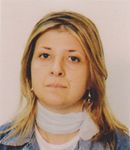 Researcher
Researcher
Marine Biotechnology Department
Tel. +39 081 5833315
Fax: +39 081 7641355
e-mail maria.costantini(at)szn.it
Research interests
Secondary metabolites from marine organisms: source of stress and biologically active compounds.
Metabolites produced by marine organisms have received increasing attention in the last decade. Notably, it has been shown that diatoms, unicellular algae, widely distributed in most aquatic habitats, produce a wide range of bioactive metabolites. Some of them (collectively termed oxylipins, including polyunsaturated aldehydes PUAs, hydroxyacids and oxo-acids) showed toxic effects on marine invertebrates. I am particularly interested in studying the molecular basis of cellular mechanisms that underlie the responses of benthic organisms to environmental stress. Currently I am studying the effects of diatom-derived oxylipins on embryonic and larval development from the molecular point of view, using sea urchin as model system
Sponges seem also to be particularly rich sources of bioactive compounds which show antiviral, antibacterial and anti-inflammatory activities. They are also promising candidates as anticancer drugs, considering that three of the four commercial anticancer drugs available have been derived from marine sponges. Several anti-inflammatory metabolites have been isolated from sponges belonging to the class of the Demospongiae, including cavernolide from Fasciospongia cavernosa, contignasterol from Petrosia contignata and cyclolinteinone from Cacospongia linteiformis. I am interested in studying the potential effects of a methanol extract from the marine sponge, Geodia cydonium and identification of its biologically active compounds.
Finally, I am interested in marine genomics and epigenetics. The aim is to investigate the functioning and the biology of marine organisms by the implementation of high-throughput genomic approaches. Through the development of genomic and proteomic tools we intend to conduct research in the areas of comparative and functional genomics aiming to the evolution, development of diversity and environmental adaptation.
Selected Publications
Costantini M, Clay O, Auletta F, Bernardi G. (2006) An isochore map of human chromosomes. Genome Research 16(4): 536-541.
Costantini M, Clay O, Federico C, Saccone S, Auletta F, Bernardi G. (2007) Human chromosomal bands: nested structure, high-definition map and molecular basis. Chromosoma 116(1):29-40.
Costantini M, Auletta F, Bernardi G. (2007) Isochore patterns and gene distributions in fish genomes. Genomics 90(3): 364-371.
Costantini M, Di Filippo M, Auletta F, Bernardi G. (2007) Isochore pattern and gene distribution in the chicken genome. Gene 400: 9-15.
Costantini M, Bernardi G. (2008) Correlations between coding and contiguous non-coding sequences in isochores families from vertebrate genomes. Gene 410: 241-248.
Costantini M, Bernardi G. (2008) Replication timing, chromosomal bands and isochores. Proc. Natl. Acad. Sci. USA 105(9): 3433-3437.
Costantini M, Bernardi G. (2008) Short-sequence design of isochores from the human genome. Proc. Natl. Acad. Sci. USA 105(37): 13971-13976.
Costantini M, Cammarano R, Bernardi G. (2009) The evolution of isochore patterns in vertebrate genomes. BMC Genomics 10: 146.
Costantini M, Bernardi G. (2009) Mapping insertions, deletions and SNPs on Venter’s chromosomes. PLoS ONE 4: e5972
Cammarano R, Costantini M, Bernardi G. (2009) The isochore patterns of invertebrate genomes. BMC Genomics 10: 538.
Romano G, Costantini M, Buttino I, Ianora A, Palumbo A. (2011) Nitric oxide mediates the stress response induced by diatom aldehydes in the sea urchin Paracentrotus lividus. PLoS ONE 6: e25980.
Costantini M, Auletta F, Bernardi G. (2012) The distribution of "new" and "old" Alu sequences in the human genome: the solution of a "mystery". Molecular Biology and Evolution 29: 421-427.
Mattiello T, Costantini M, Di Matteo B, Livigni S, Andouche A, Bonnaud L, Palumbo A. (2012) The dynamic nitric oxide pattern in developing cuttlefish Sepia officinalis. Developmental Dynamics 241: 390-402.
Marrone V, Piscopo M, Romano G, Ianora A, Palumbo A, Costantini M. (2012) Defensome against toxic diatom aldehydes in the sea urchin Paracentrotus lividus. PLoS ONE 7: e31750.
Costantini S, Sharma A, Raucci R, Costantini M, Autiero I, Colonna G (2013) Genealogy of an ancient protein family: the Sirtuins, a family of disordered members. BMC Evolutionary Biology 13: 60.
Costantini M, Alvarez-Valin F, Costantini S, Cammarano R, Bernardi G. (2013) Compositional patterns in the genomes of unicellular eukaryotes. BMC Genomics 14: 755.
Guariniello S, Colonna G, Raucci R, Costantini M, Di Bernardo G, Bergantino F, Castello G, Costantini S. (2014) Structure-function relationship and evolutionary history of the human selenoprotein M (SelM) found over-expressed in hepatocellular carcinoma. BBA – Proteins and Proteomics 1844: 447-456.
Varrella S, Romano G, Ianora A, Bentley MG, Ruocco N, Costantini M. (2014) Molecular response to toxic diatom-derived aldehydes in the sea urchin Paracentrotus lividus. Marine Drugs 12: 2089-2113.
Zuppa A, Costantini S, Costantini M. (2014) Identification of bacterial symbionts from the marine sponges Geodia cydonium and Ircinia muscarum. Bioinformation 10(4): 196-200.
Costantini M. (2015) An overview on genome organization on marine organisms. Marine Genomics pii: S1874-7787(15)00057-4.
doi: 10.1016/j.margen.2015.03.015.
Costantini S, Romano G, Rusolo F, Capone F, Guerriero E, Colonna G, Ianora A, Ciliberto G, Costantini M. (2015) Anti-inflammatory effects of a methanol extract from the marine sponge Geodia cydonium on the human breast cancer MCF-7 cell line. Mediators of Inflammation Article ID 204975.
Guariniello S, Colonna G, Guerriero E, Capone F, Costantini M, Di Bernardo G, Accardo M, Castello G, Costantini S. (2015) Sequence and structure analysis of human selenoprotein 15kDa (Sep15), an up-expressed protein in the hepatocellular carcinoma. International Journal of Research Studies in Biosciences 3(9), 1-14.










